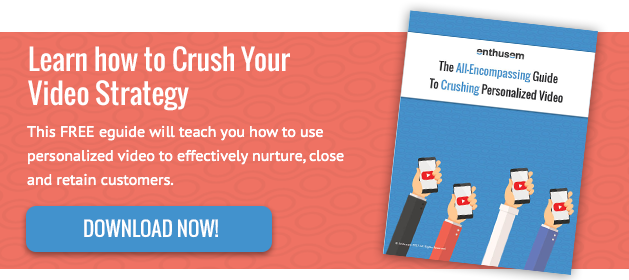3.5 Retargeting Best Practices to Make the Most of Your Budget
Marketing | Sales | Offline Marketing | Online Marketing | lead nurturing
As a marketer, you work hard to drive prospects to your website. Through organic search, social media, banner ads and more, you’re positioning your businesses as a resource worth a prospect’s click. Just getting them to your site is a win of sorts, but it’s far from the ultimate prize. In fact, only 2% of website traffic converts on the first visit.
In order to drive consistent leads and sales, you need to spend some of your resources on following up with prospects and continuing to deliver targeted and engaging messaging. A drip marketing strategy that’s grown in popularity is retargeting. Also known as remarketing, retargeting is a method of tracking your website visitors and presenting them relevant content after they’ve left for another site.
A familiar example is when someone visits a product page on Amazon, leaves for another site and sees that same product in an ad. A code embedded on the webpage marks a browser cookie on the visitor’s IP address, so when they navigate to other sites, the retargeting provider will serve the Amazon ad to that prospect.
There are many approaches to retargeting beyond displaying product ads. Serving an ad immediately after a site visitor moves on may not be the best use of your marketing dollars. Especially if you have a longer sales cycle, you’d want to be more deliberate and strategic about when you serve retargeted ads to your prospects.
In this post, we’ll discuss four best practices that will help you leverage retargeting to increase your conversions.
1) Don’t Bombard Your Prospects or Customers
If a prospect has shown some interest in your company or product, the last thing you want to do is push them away. Bombarding prospects with ads will do a better job at turning them off than encouraging them to buy. More impressions does not always equal greater conversions.
Retargeting platforms allow you to limit the number of times you show a specific ad to a prospect. These frequency caps allow you to be more strategic about how often you expose your messaging in a given day, week or month. Retargeter recommends limiting retargeting ads to 17 to 20 ads per month for any given site visitor. This figure is incredibly general, however. Your target audience and objective must define what frequency is sensible.
Beyond how many times you show a prospect an ad, how long you run a campaign is equally important. Retargeting tools allow you to choose the lifespan of your site cookie, which essentially tells your site when to forget about a prospect. Naturally, how long you expose your ads to a prospect depends on your sales cycle and the stage of your buyer’s journey.
If you’re targeting a bottom-funnel lead who’s close to buying, your window of opportunity is relatively short. You may run a retargeting campaign for a week or less. But if you’re targeting a top-of-the-funnel prospect, you have more time to make an impression. This campaign could last for three months.
Your audience may include existing customers, too. Without proper planning, you could show ads to a customer who already purchased your product or service. If they continually see an ad for something they’ve already bought, they could easily become frustrated. Considering how valuable your current customers can be, you don’t want to do anything that may fray your relationship them.
2) Segment Your Audience to Create Engaging Content
Prospects at different stages in their buyer’s journey have different needs and interests. You can’t expect to display the same retargeting ad to every site visitor and expect the same results. You need to segment your audience into similar personas to determine what message will resonate most.
Say a prospect visits your product comparison page. You can reasonably assume that visitor is farther along in the buyer’s journey and is weighing their options. They’ve identified the kind of solution that could best solve their problems and are now determining how the differences between like-solutions may impact their experience. What message would resonate with such a prospect? Perhaps you’d promote a case study that details how a similar persona used their product to solve their problem.
Use segmentation to identify key indicators of user behavior, product category preference, previous shopping history, internal user scoring of the retailer and volume of offers viewed. By segmenting your audience into prospects who share common concerns and sticking points, you can create different creative that relates to their behaviors and the content on your site.
You can also segment prospects a step further, identifying prospect who have taken specific actions that might indicate they are close to converting. Many marketers target prospects who’ve left a product in their shopping cart or downloaded a couple of their content offers. Delivering a retargeting ad that promotes influential bottom-of-the-funnel content or an offer to speak could nudge these leads to close.
Learn how to effectively personalize your video strategy at scale through our Guide to Crushing Personalized Video.
3) Test. Adjust. Test. Adjust.
If you’ve done the legwork to create relevant ads, you don’t want to stop short and simply forget about your retargeting campaign as it runs. You need to test how your ads are performing and adjust to make the most of your investment. You might A/B test different images, colors or messages used in your ads. After some time, you may find that one image significantly outperforms another. Why continue showing the less-effective ad?
Don’t make the mistake of making conclusions before you have a significant sample size, though. You may need at least two to four weeks and 500 clicks before you can reasonably make insightful conclusions from your campaign data.
When you do have enough information, you may find out that retargeting simply isn’t producing results with a specific persona segment. You might try taking a different approach, but you could also be better served completely removing an audience from your campaign. Plan ahead for what you constitute as worthy (or unworthy) cost of your campaign – either cost-per-click, cost-per-impression or cost-per-acquisition.
3.5) Don’t Neglect On-Site Retargeting
While retargeting prospects after they’ve left your site can be effective, perhaps a better use of your resources is to try to keep site visitors from leaving in the first place.
What if a prospect would have stayed on your site if they already knew about the aforementioned case study? If you promoted that piece of content on your product comparison page, they might have downloaded it right then and there.
Marketers use in-line CTAs, banner CTAs and pop-up CTAs to promote relevant content across their websites. If you have content offers that might interest certain personas, strategically place them on pages that they frequently visit. Not only will you capture their contact information from your landing pages, but you may ultimately cut back on your retargeting spend, saving those ads for more direct sales messaging.
Whether you’re promoting B2B or B2C solutions, you can re-engage your prospects with a strategic retargeting campaign. Make the most of your marketing dollars and place the right message to the right person at the right time.
Modern marketers are increasingly using personalized video to effectively nurture, close and retain customers. Click below to download The All-Encompassing Guide To Crushing Personalized Video.






